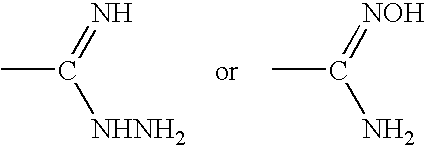Perfluoroelastomer Compositions Including Barium Titanate Fillers
a technology of perfluoroelastomer and filler, which is applied in the direction of mechanical equipment, transportation and packaging, and other chemical processes, can solve the problems of high temperature resistance, limited moldability and bondability, and high cost of latex blending, and achieves enhanced thermal resistance, short crosslinking time, and good mechanical properties.
- Summary
- Abstract
- Description
- Claims
- Application Information
AI Technical Summary
Benefits of technology
Problems solved by technology
Method used
Image
Examples
example 1
[0195]A compound used in this Example is shown below. The compound (NPh-AF) represented below is used as a curing or crosslinking agent.
preparation example 1
Synthesis of Perfluoroelastomer (1)
[0196]Into a 6-liter stainless steel autoclave having no ignition source were poured 2.34 liters of pure water, 23.4 g of
as an emulsifying agent and 0.21 g of (NH4)2CO3, and the inside of the system was sufficiently replaced with nitrogen gas and subjected to deaeration. Then, the autoclave was heated up to 52° C. with stirring at 600 rpm, and a gas mixture of tetrafluoroethylene (TFE) and perfluoro(methyl vinyl ether) (PMVE) (molar ratio of TFE / PMVE=22 / 78) was introduced so that the inside pressure became 0.78 MPa·G. Then, after introducing 0.82 g of CF2═CFO(CF2)5CN with pressurized nitrogen gas, a solution prepared by dissolving 12.3 g of ammonium persulfate (APS) in 30 g of water, was introduced with pressurized nitrogen gas to initiate a reaction.
[0197]As the polymerization proceeded, the inside pressure of the reactor decreased, and pressurized TFE and PMVE were introduced so that the inside pressure became 0.78 MPa·G. Until completion of the ...
example 2
Preparation Example 2
Synthesis of Perfluoroelastomer (2)
[0200]Into a 6-liter stainless steel autoclave having no ignition source were poured 2.34 liters of pure water, 23.4 g of
as an emulsifying agent and 0.21 g of (NH4)2CO3, and the inside of the system was sufficiently replaced with nitrogen gas and subjected to deaeration. Then the autoclave was heated up to 52° C. with stirring at 600 rpm, and a gas mixture of TFE and PMVE (molar ratio of TFE / PMVE=41 / 59) was introduced so that the inside pressure became 0.78 MPa·G. Then, after introducing 0.87 g of CF2═CFO(CF2)5CN with pressurized nitrogen gas, a solution prepared by dissolving 12.3 g of APS in 30 g of water, was introduced with pressurized nitrogen gas to initiate a reaction.
[0201]As the polymerization proceeded, the inside pressure of the reactor decreased, and pressurized TFE and PMVE were introduced so that the inside pressure became 0.78 MPa·G. Until completion of the polymerization, 400 g of TFE and 284 g of PMVE were intr...
PUM
| Property | Measurement | Unit |
|---|---|---|
| particle size | aaaaa | aaaaa |
| particle size | aaaaa | aaaaa |
| particle size | aaaaa | aaaaa |
Abstract
Description
Claims
Application Information
 Login to View More
Login to View More - R&D
- Intellectual Property
- Life Sciences
- Materials
- Tech Scout
- Unparalleled Data Quality
- Higher Quality Content
- 60% Fewer Hallucinations
Browse by: Latest US Patents, China's latest patents, Technical Efficacy Thesaurus, Application Domain, Technology Topic, Popular Technical Reports.
© 2025 PatSnap. All rights reserved.Legal|Privacy policy|Modern Slavery Act Transparency Statement|Sitemap|About US| Contact US: help@patsnap.com



